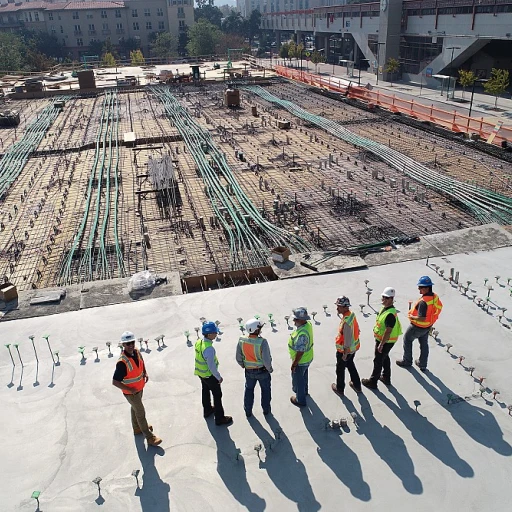
The Interconnection of Business Processes and Work-Life Balance
Integrating Business Processes for Enhanced Work-Life Satisfaction
The intricate web of business processes forms the backbone of any organization's daily operations, directly influencing an employee's work-life balance. Recent studies from HR training changes post-COVID have highlighted how evolving business dynamics impact both business efficiency and employee satisfaction.
Business processes are not just about task execution. They are deeply interconnected with organizational culture, where the way employees feel and behave is a reflection of the underlying corporate culture. Well-optimized management systems facilitate knowledge management, enhancing overall job satisfaction among team members.
Organizational Changes and Their Role in Employee Satisfaction
Modern companies are increasingly recognizing the need for agile change management. By evolving business process frameworks and embracing flexible work practices, organizations can adapt to the complexities of today's business landscape. These systems must be designed to blend seamlessly with the company culture, ensuring that processes do not add to employee stress but instead foster a more harmonious work environment.
Leadership is crucial in aligning business management objectives with employee values. Progressive decision-making that incorporates expert systems, such as fuzzy logic, can significantly impact organizational behavior, promoting a culture of continuous improvement and adaptability.
Conclusion
In conclusion, the relationship between business processes and work-life balance is symbiotic. For employees to experience job satisfaction, fully integrated and flexible systems are essential. Organizational leaders must spearhead this change to ensure their teams can achieve a healthy balance between professional responsibilities and personal life.
Cultural Norms and Their Impact on Work-Life Harmony
Influence of Cultural Norms on Workplace Harmony
Understanding the influence of cultural norms on work-life balance is crucial for developing an effective organizational structure. In every organization, whether global or local, company culture plays a decisive role in shaping employees' behaviors and expectations. Organizational culture impacts how work is structured, how decisions are made, and how flexible or rigid the processes are. Different organizations develop unique cultures that embody their values and beliefs. These cultural norms shape how team members interact, how they balance job demands with personal life, and how satisfied they feel with workplace flexibility initiatives. Employees' satisfaction significantly depends on their alignment with the organization's culture and values.The Impact of Cultural Norms on Employee Job Satisfaction
Within the realm of organizational behavior, cultural norms carry significant weight in influencing employee job satisfaction. When there is a strong alignment between individual values and organizational culture, employees tend to report higher job satisfaction. This alignment also facilitates smoother decision making and enhanced change management processes, as individuals work in synergy to achieve common organizational goals. On the contrary, when discrepancies arise between personal beliefs and company culture, it could lead to friction, dissatisfaction, and reluctance to embrace new management systems or business processes. For effective organizational change, understanding and incorporating employees' cultural backgrounds become pivotal.Navigating Business Processes within Cultural Contexts
The way business processes are designed and managed also hinges on cultural norms. Harvard Business Review emphasizes that knowledge management and behavior organizational are heavily influenced by these norms. As organizations evolve, the need for developing expert systems that reflect multicultural values gains prominence. This integration ensures that business management strategies are responsive to cultural diversity and promote an inclusive workplace. A well-structured company culture that encourages flexible processes and respects cultural diversity often results in employees feeling valued and appreciated, thus enhancing job satisfaction. For organizations aiming to improve their work-life balance framework, considering the cultural diversity of their employees and appropriately tailoring their business processes is a key strategy. For further insights into developing effective cultural strategies, explore our strategies to reward clinic team members which provide practical approaches to aligning company culture with employee needs and expectations.Behavioral Patterns in the Workplace
Understanding the Influence of Employee Behavior in the Workplace
The dynamics of corporate culture and organizational behavior play a pivotal role in shaping employees’ work-life balance. Employees' actions and decision-making processes significantly contribute to achieving satisfaction and harmony at work. When exploring this issue, it is essential to consider the impact of organizational culture, management systems, and knowledge management on employee behavior. Organizations that emphasize supportive environments often report higher levels of job satisfaction and enhanced work performance. The relationship between employee behavior and business processes is central to understanding how employees feel about their work. Team members' behavior in an organization can influence and drive positive change when aligned with the company's goals and values. Business management and leadership frameworks, such as those discussed in various Harvard Business Review articles, advocate for leaders to actively engage with their team members. This engagement fosters a culture that encourages open communication, feedback, and personal development. Such a behavioral approach not only improves employee satisfaction but also strengthens the entire organizational culture. Incorporating change management and behavioral organizational strategies within a company culture is crucial. Implementing expert systems and leveraging fuzzy logic can help organizations adapt to evolving work environments, thus promoting a balance between work and personal life. Effective knowledge management facilitates this transition, ensuring that employees possess the necessary resources to adapt to new processes. Moreover, recognizing behaviors that embody the company's values can aid in driving satisfaction across different organizational tiers. For more insights into boosting associate engagement, you can explore inspiring approaches to elevate business culture and employee involvement. Emphasizing positive behavioral patterns in alignment with corporate culture can pave the way to a more balanced and fulfilling work life in any organization.Strategies for Enhancing Work-Life Balance
Implementing Practical Approaches to Achieve Harmony
In the quest for achieving work-life balance, organizations need to adopt effective strategies that accommodate both business objectives and the well-being of employees. Balancing these aspects can enhance job satisfaction, foster a positive organizational culture, and promote a more resilient workforce. Firstly, understanding the integral link between organizational culture and employee satisfaction is essential in creating a nurturing work environment. A company's core values, as reflected in its culture, often dictate how employees feel about their roles. These values can greatly influence processes like change management and decision making, crucial for maintaining harmony between personal and professional life. Several strategies stand out when it comes to boosting work-life balance:- Flexibility in Work Arrangements: Implementing flexible work policies, such as remote work and customizable hours, can significantly reduce stress and improve work-life harmony. By acknowledging that employees have diverse personal commitments and responsibilities, companies can show support and foster a sense of trust and autonomy.
- Encouraging Employee Feedback: Regularly soliciting feedback through surveys or open forums helps identify potential stressors and areas for improvement in the work environment. This feedback loop between management and team members contributes to more effective change management and enhances organizational behavior.
- Offering Development Opportunities: Providing access to skill-enhancement programs and promoting knowledge management can lead to increased employee satisfaction. Employees who feel they are steadily advancing their knowledge and careers are more likely to remain engaged and motivated.
- Creating Robust Support Systems: Establishing systems that offer support to employees, such as mental health resources or wellness programs, can be pivotal. This approach not only aids in mitigating stress but also aligns with the business process of prioritizing employee well-being.
The Role of Leadership in Shaping Work-Life Balance
The Influence of Leadership on Organizational Balance
Within the intricate systems of business processes and culture, leadership plays a pivotal role in shaping an organization's work-life balance. Through effective decision making and knowledge management, leadership can significantly impact the overall employee satisfaction and organizational culture. While many factors contribute to an employee's perception of their work-life harmony, leadership is often at the forefront of fostering a positive and flexible environment.
One of the primary responsibilities of leadership is to be deeply engaged in change management processes. As organizations evolve, leaders need to adapt management systems and business processes that support both organizational goals and employee well-being. Instilling values that emphasize the importance of job satisfaction can enhance the corporate culture, creating an environment where employees feel valued and motivated.
Leadership behavior within the organizational framework can either cultivate harmony or create stress. Leaders set the tone for corporate culture by demonstrating respect for work-life boundaries. By promoting a realistic work schedule and encouraging time-off policies, they not only align with employee needs but also enhance overall team productivity and creativity. Harvard Business Review highlights that organizations with mindful leadership in place experienced improved employee retention and engagement.
Moreover, understanding the unique needs of team members through expert systems and behavioral organizational insights can prepare leaders to better allocate resources, streamline business process efficiency, and ensure that employees have a balanced work approach. In the quest for a harmonious work atmosphere, it becomes essential that leaders are also advocates for change, ready to steer the organization towards practices that are both sustainable and employee-centric.
Ultimately, leadership's role extends beyond simple management. It requires a transformation of values that resonate throughout the company culture. Embedding a thoughtfully designed leadership strategy can lead to a flourishing work-life balance that not only benefits the organization but also cultivates a loyal and motivated workforce.












